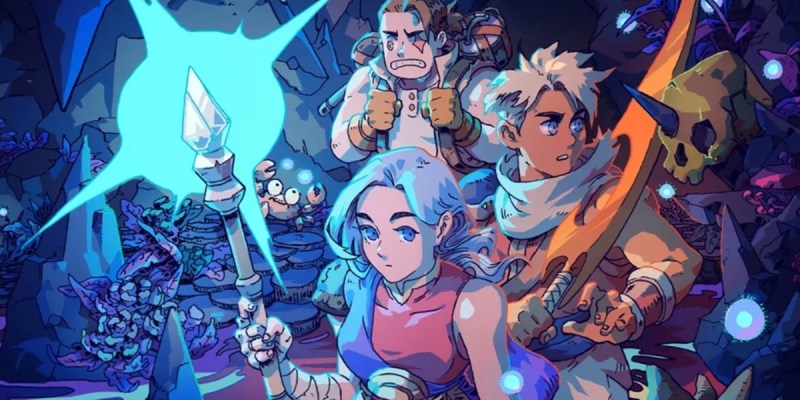The amazing RPGs, they won’t stop coming this year! It’s been hard to pay all the attention to Sea of Stars that it deserves, but I’m quite happy with my playtime so far, and this is coming from someone who traditionally has struggled a bit with retro RPGs. What magic did Sabotage Studio (of The Messenger fame) employ here?
Folks who are more familiar with this specific type of RPG likely have better answers, but as far as I’m concerned, Sea of Stars triumphs where many other “retro homages” have fallen short because it’s looking at the future despite its old-fashioned aesthetics and earnest heart. Much like The Messenger before it, Sea of Stars understands the time of the games it has reverence for ended long ago. Sabotage Studio could either retread old ground with their games or actually update their formulas, which typically involves adding more than a couple of cute mechanics to what has worked before. Thankfully, it appears the studio excels at making the right adjustments and spicing things up without upsetting the old guard.
Even if I wasn’t a big fan of the refreshed turn-based combat system and streamlined mechanics of Sea of Stars, it’d be hard to resist the allure of its presentation, which perfectly evokes SNES-era classics while making good use of a fraction of the extra horsepower which any piece of modern hardware packs. There’s an amazing depth to each piece of scenery, the characters are lively and have memorable designs that never feel overdone, and the music can be both catchy and soothing without taking much of the attention way from what’s happening on the screen.
I’ll admit I’ve got a soft spot for retro graphics even if I’m usually the type of player who’d rather push forward than stay for too long in the past. The visual creativity on display across many classics is staggering, often born from the technical limitations of the console generations available during my childhood years. Even the transition to 3D in triple-A games (if such a thing even existed back then) didn’t instantly vaporize the problem of making a blob of pixels and polygons look reasonably human-like.
Sea of Stars looks the part, but – much like Signalis last year – understands there’s no need for overdoing the retro posturing beyond what’s necessary to tickle the nostalgic part of our brains. Too many “retro” indie titles fall down a rabbit hole of self-limiting design choices and excessive worship that shoot down their own potential to truly become something meaningful and worth picking up.
Extra spice was also added in healthy doses (much to my surprise) to the agile yet profoundly classical combat system, which doesn’t drop turns, but makes the whole thing less boring and actually enjoyable in 2023. For the most part, the big RPG studios still doing those have moved past the inert, scroll-heavy turns featured in the “golden age” of party-based adventures, and even Pokémon is facing some criticism nowadays when it comes to the mainline series’ stagnant mechanics. Sea of Stars isn’t exactly rewriting the book on RPG turns, but there’s a special rhythm to it keeping me from yawning and looking at my phone every two turns.
In fact, almost every aspect of the traditional RPG formula has undergone some sort of change or improvement to make Sea of Stars more than a cheap trip down memory lane. Quite the opposite; Sabotage Studio’s latest might be one of the most inviting RPGs of 2023 for newcomers to the larger genre. If Baldur’s Gate 3 feels like a perfect intro to CRPGs and Starfield has managed to expand the horizons of Bethesda’s own brand of open-world action role-playing game, then Sea of Stars could be recommended as a pleasant and utterly charming first foray into the world of top-down RPG odysseys.
More importantly, this game might’ve done just enough to make sceptics like me vibe for real with a breed of RPG I never thought I could fully love outside of cutesy visuals and captivating tunes (the main reasons why I’ve never given up on Pokémon). I’ll stick around to find out what awaits at the end of Valere, Zale, Garl, and the crew’s journey because listening to their innocent blabber and slaying the roaming monsters and foes of each area I visit doesn’t feel like a chore. No cutscene or unskippable dialogue goes on for too long, and enemy encounters require me to use more than two brain cells. All’s on the right track, I reckon.
All this positive talk doesn’t negate the fact Sea of Stars’ progression system still looks pretty pointless to me (I barely have any control over how my character evolves) or that checkpoints more often than not feel off given how tough some of the fights can be past the first few areas. But at the end of the day, this little big RPG understands the draw of a good, old-fashioned adventure far better than many mind-bogglingly expensive titles and doesn’t dwell on the past too much. That’s quite the achievement.


